Do you want to learn how to respond to negative reviews?
Online reviews are crucial in shaping a business’s online reputation in today’s digital age. Positive reviews can attract new customers, increase sales, and improve brand credibility.
However, negative reviews can have a significant impact on a business, both in the short and long term.
In this article, I’ll teach you how to respond to negative reviews with the help of examples. You will also find free negative review response templates to get going.
- The Impact of Negative Reviews for Your Business
- Why Responding to Negative Reviews Is Important
- How To Respond to Negative Reviews (With Examples)
- Negative Review Response Templates
- Industry-Specific Negative Review Response Templates
Let’s start with how negative online reviews impact your business and why responding to negative reviews is important.
The Impact of Negative Reviews for Your Business
Negative reviews can impact your business in the following ways:
-
Loss of Potential Customers
Negative reviews can turn away potential customers. According to a study, 84% of people trust online reviews as much as personal recommendations. Another study tells 74% of consumers say that positive reviews make them trust a local business more.
Conversely, if a business has many negative reviews, potential customers may choose to take their business elsewhere.
-
Hurts Brand Reputation
Negative reviews can damage a business’s brand reputation. When customers leave negative reviews, they share their negative experiences with the world. This can lead to a decline in customer loyalty and a loss of trust in the brand.
76% of all reviews are either Google reviews or Facebook reviews, meaning what is being said about you is public knowledge. It can also lead to negative word-of-mouth marketing, where customers share their negative experiences with friends and family.
Resource: 10 Best Reputation Management Tools
-
Affects Search Ranking
Negative reviews can impact a business’s search engine ranking. Search engines, like Google, consider the quality and quantity of reviews as a ranking factor.
A business with more negative reviews than positive ones may see a drop in its search engine ranking. This makes it harder for potential customers to find them online.
But the good news is that negative reviews don’t necessarily have negative consequences. Sometimes they add a bit of authenticity to your brand.
If all of your reviews are positive, they come off as fake social proof. So when you have a few reasonably negative reviews peppered in there, people tend to trust your brand even more.
Data tells us 52% of consumers trust a software product more if it has negative reviews. Another statistic argues that negative reviews can increase conversions by up to 85%.
Resource: SEO Made Easy—Ultimate Guide to Explode Your Traffic
Why Respond to Negative Reviews Is Important
We just saw how damaging negative reviews can be for a business. It only makes sense to have a negative reviews response strategy to be always ready. In addition to that, responding to negative reviews can also have the following benefits:
-
It Shows You Care
Responding to negative reviews shows that a business cares about its customers. Customers want to feel valued and heard, and responding to their negative feedback indicates that a company takes their concerns seriously.
-
Damage Mitigation
Secondly, responding to negative reviews can help mitigate the damage caused by the review. By acknowledging the customer’s concerns and apologizing for any negative experience, a business can show that they take customer satisfaction seriously.
This can minimize the negative review’s impact and turn a dissatisfied customer into a loyal one.
-
Provides Feedback
Thirdly, responding to negative reviews can provide valuable feedback for the business. Negative reviews can highlight areas where a business needs to improve its product or service.
A business can prevent similar negative reviews by listening to customer feedback and addressing the issues raised, improving its overall customer experience.
Now, let’s look at 13 negative review response examples and tips on how to respond to negative reviews.
How To Respond to Negative Reviews (With Examples)
Before diving into the negative stuff, I quickly wanted to address what you should do with the positive reviews you get.
Many marketers leave these on 3rd-party review sites, which is a huge missed opportunity.
Instead, why not display positive reviews on your site with TrustPulse?

TrustPulse is the world’s best social proof software. It lets you quickly and easily create social proof notifications to display across your site.
And since it integrates with Zapier, you can capture activities from 3rd-party review sites like Google My Business and Yelp.
Or, you can create a default notification for one of your highest-rated reviews. Then add a link to that external site, so users can quickly see it themselves.
No matter how you show your positive reviews, TrustPulse gives you a way to leverage the great things people are saying about your brand to boost sales and conversions.
I’ve seen TrustPulse users increase sales by 15% simply by displaying social proof notifications.
Want to see it in action for yourself? Sign up for your 100% risk-free TrustPulse account today!
Now that we know how to handle positive reviews, let’s check out different ways how to respond to bad reviews.
1. Respond Quickly
One of the biggest problems companies face is failing to respond quickly to a negative review. And it’s understandable.
You have an entire business to run. You have employees who get sick, shipments that come in late, and about a million other fires that must be put out daily. One bad review on Yelp might not be at the top of your radar.
But it should be.
As soon as you’re aware of a negative review, set 5 minutes aside to address it. If you put it off too long, it makes your eventual apology come off as insincere. Since most online reviews are date-stamped, customers can see how long it took for you to get back to them:
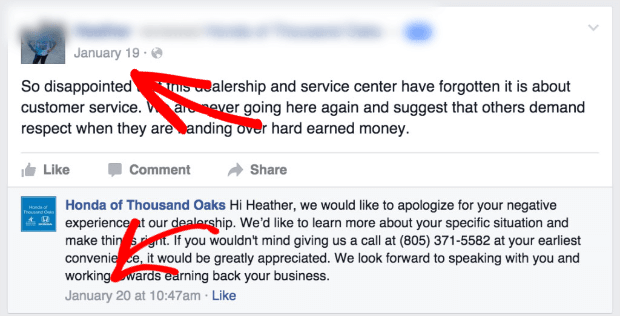
Plus, putting off a response often means the job doesn’t get done at all.
2. Respond Always
This tip may be controversial. Some companies will tell you that the first thing you should do is decide if a response is even necessary.
They argue that some bad reviewers are “online bullies.” And at the end of the day, you can do nothing to improve the situation.
That’s a fair point in some extreme cases, but I recommend a different approach: hold your head up high and respond always.
Remember, you aren’t simply responding to the negative reviewer. You’re responding to the thousands of potential customers reading the negative review. More often than not, people can tell when a complaint is valid, or the reviewer is too aggressive.
If the complaint is valid, you look like a company that truly understands the importance of good customer service. If the complaint isn’t valid, you still come out on top by taking the high road.
3. Don’t Take the Negative Review Personally
A bad customer review feels like a personal attack. And in some ways, it is, especially when you’re the business owner.
That’s because a negative review can negatively affect your business’s success.
But even if you are the face of your brand, remember that the customer doesn’t know you personally. They don’t know how great you are, how much you care about their experience with
your product, and how badly you want to serve your customers.
Here’s a negative review response example of a business owner likely taking a review too personally:

This is a funny response if you’re not involved in the situation or plan on going to that particular restaurant.
But this reply is actively repelling potential customers away.
Instead, use a negative review to give your audience a glimpse into your personality. And let them get to know your kindness and empathy through that response.
4. Introduce Yourself and Your Connection to the Team
It’s always great to see a company owner take the time to respond to a humble customer review. This is what entrepreneur Gary Vaynerchuk responded to criticism of his book:

But sometimes, getting a response from the business owner is unrealistic.
It’s hard enough for the owner of a small business to respond to every online review they receive. As a business grows, it becomes near impossible.
Sometimes you might find yourself responding to a negative review on your company’s behalf. If so, introduce yourself and tell the reader about your team connection.
That way, they don’t feel like a random stranger is chiming in to smooth things over.
5. Thank the Customer for Taking the Time to Write
The truth is that whenever someone writes anything about your product, they feel strongly about your business. And that goes for both positive and negative reviews.
One of the marketing goals is just getting people to talk about you. So even when someone says something not so nice, you should thank them for taking the time to do so. This accomplishes a few things:
- It quickly diffuses the negativity
- It makes your reviewer feel heard and valued
- Shows other readers that you aren’t petty
Starting with a small phrase like, “Hey, thanks so much for taking the time to write” is the perfect introduction for your response to a negative review.
Here’s a great negative review response example that shows how to thank customers right off the bat:
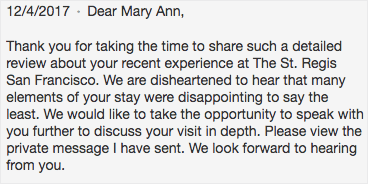
6. Make Your Response Authentic and Personal
At the end of this article, I’ll give you some templates to respond to negative reviews. However, you’ll want to use those templates as a basic guideline.
Not something to copy/paste 100% verbatim.
People can tell now when you respond with a canned response. Since negative reviews can impact your business, you should take the time to make them personal to the reviewer.
Address them by name and introduce yourself. The goal is to humanize this interaction as much as possible. This dentist made his response very personal when someone’s girlfriend was dissatisfied with getting a new crown:
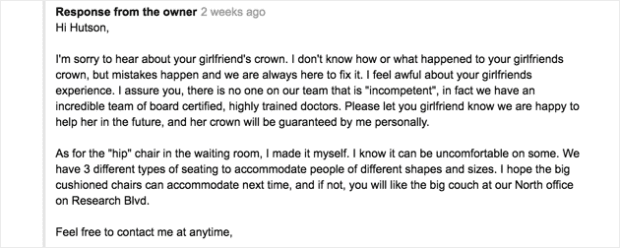
So before you hit “send,” reread your response and ask yourself what makes the message unique to the reviewer. In other words, would it still work if you copied and pasted this response for any other negative review?
If so, try to make it sound more personal.
7. Show Empathy and Understanding
When someone writes a negative review about your product or company, the first response is usually to get defensive. And those feelings are ok! It’s totally normal, and everyone does it.
But that doesn’t make it the best way to handle the situation.
Instead, try to put yourself in your customer’s shoes. They were mad enough to write about their experience, and it’s your job to figure out why.
More often than not, that negativity can be chalked up to a bad day and someone needing to blow off steam.
Remind yourself that the author of the review is a human being. Maybe they’re having issues at home or at work. Or maybe they stayed up all week because their kid is sick, and now they’re just trying to get through till Friday.
As you write your message, empathize with the author, and imagine yourself on your worst day. This will help you feel compassion for them and prevent you from getting overly defensive or emotional about the situation.
Check out this negative review response example which is beaming with humility, empathy, and understanding:
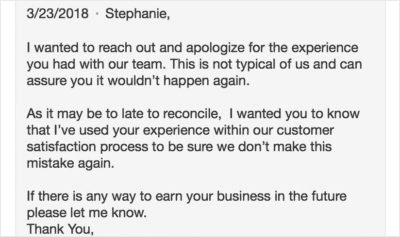
8. Reinforce Your Company’s Standard Values
In your response, let the reviewer (and other readers) know that this negative experience is the exception, not the rule.
To do that, briefly mention your current customer service standards. Let them know that you take your client’s complaints very seriously and that customer service is integral to your company’s values.
You don’t need to go on and on about this either.
A simple sentence like “We here at [your business name] take a lot of pride in our customers’ success, which is why…” will reinforce your commitment to providing exceptional service.
Again, this shows the reviewer that you’re taking their problem seriously. But it also shows the many other readers that your business is there to help them when needed.
9. Offer a Discount, Promotion, or Refund for the Inconvenience
This is an optional though highly recommended step. And different marketers have different feelings on the topic. Here’s why:
Offering a discount, a special promotion, or a refund to customers who wrote a negative business review can help ease tension. It’s also a great way to prepare yourself to ask for a testimonial after the problem gets solved.
Others, however, are concerned that you’ll train your customers to leave bad reviews so they can get free stuff.
While there is probably some truth to the latter’s opinion, I think it’s a bit too cynical. And if you’re attracting the kind of customers that would do that, you’re probably attracting the wrong kinds of leads, anyway.
Instead, I like to think that most customers are good. And if they have a bad experience with your brand, a small discount or coupon can go a long way in regaining a lifelong customer.
Here’s a negative review response example from JetBlue Airways:
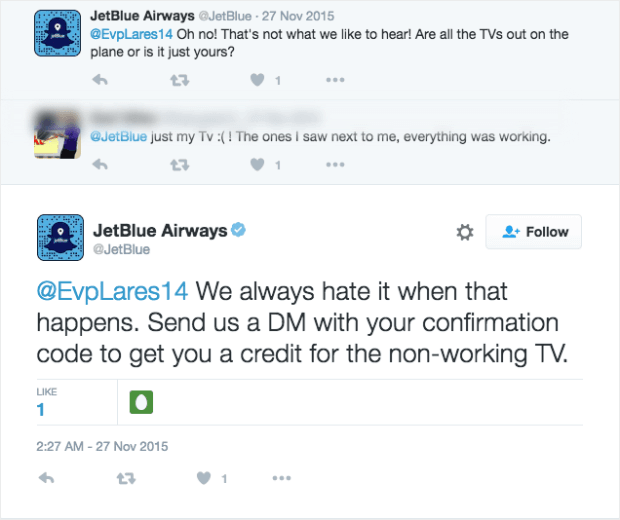
But the most famous example is from a clothing store called Nordstroms. Back in the mid-’70s, Nordstroms opened a store in Alaska. But ten years before, a man had bought tires from the store that had previously occupied Nordstroms’ new space.
And he wanted a refund for those tires.
He took them in on opening day without a receipt (not that a receipt would help), and Nordstroms gave him a full refund. Nordstroms is now known for its legendary customer service.
But guess what?
Today, nobody is lining up to return their tires. Real customers love the brand so much they don’t dare abuse the retailer’s kindness.
10. Understand the Difference Between “I Apologize” and “I’m Sorry”
Comedian Demetri Martin perfectly demonstrates this difference by saying, “Saying ‘I’m sorry’ and saying ‘I apologize’ are the same thing. Except at a funeral.”
When you say, “I apologize,” you are taking responsibility for something that was your company’s fault. Take this business owner’s response, for example:

When you say, ‘I’m sorry,’ you may be empathizing with your customer without acknowledging that your company was specifically to blame. Here’s a negative review response example of a business doing just that:
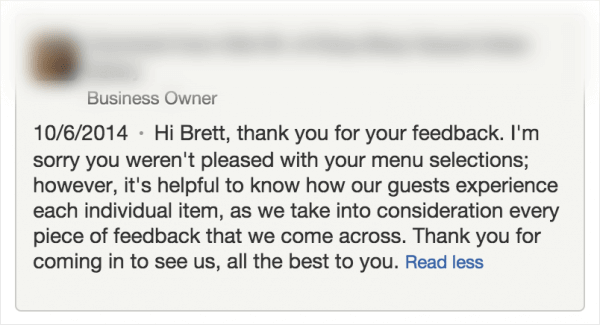
As a business owner, you are obligated to give your customers the best service possible. But that doesn’t mean you need to be a punching bag for every critic.
If there is a negative review because of something you are responsible for, apologize.
If there is a negative review because of something outside of your control, then you have every right to take the “I’m sorry this happened to you” approach.
11. Keep It Short
I know when I get a bad review, it can feel like a personal attack. My fingers tingle, and I get eager to write back in self-defense.
But the last thing you want to do in responding to a negative review is ramble. For a few reasons:
- Most people will ignore reading longer responses
- Longer replies come off as desperate or defensive
- There’s simply no need for drawn-out explanations
The bottom line is you have a unhappy customer. If it’s your fault, apologize. If it’s not, show empathy.
Either way, you shouldn’t validate the negative review with a long response. Gracefully reply with the tips I’ve already given. Here’s a negative review response example that shows how powerful a short message can be:

To go the extra mile, take the conversation offline to express yourself at greater length, which brings us to our next tip.
12. Take the Conversation Offline
If you use all the tips I’ve described above, you should be able to pacify even the most frustrated customer.
But it’s like they say, “You can’t please everyone.”
So while you should publically respond to any negative comment on the platform where it was posted, you should also continue the conversation on your terms.
And that means moving to a private platform.
Whether you decide to work with the customer on a phone call, video chat, or in a direct message on your favorite social media platform, move the conversation somewhere more private.
Here’s a negative review response example from a company responding to someone who was dissatisfied with their meal:

Note that it’s short, to the point, and quickly takes the conversation to another platform.
13. Turn the Negative Review Into a Testimonial
I already mentioned that not all negative reviews hurt your business. Sometimes they can help.
But if you want to turn your lemon reviews into lemonade, you should follow up with the author of your negative review.
More specifically, ask if the issue was resolved and, if so, whether or not you can get some public feedback on their experience.
Seeing someone go from being angry enough to write a bad review to give a glowing testimonial will speak volumes about your company’s values.
Other readers can see that you take customer complaints seriously and care about making clients happy.
A testimonial from someone who had previously written a bad review is likely one of your most powerful lead generating tactics.
Check out this example involving a car dealership. The owner responded to a negative review with this:
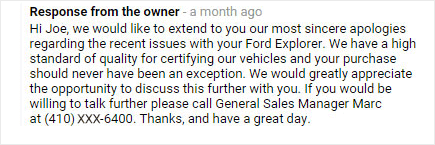
And the follow-up review came later from the customer:
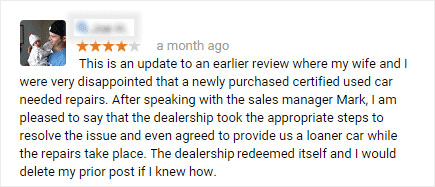
This small paragraph is a testament to the company’s high customer service standards.
Now that I’ve discussed 13 ways how to respond to negative reviews, here are six templates to save you time.
Negative Review Response Templates
When it comes to responding to negative reviews, you only have two types of responses:
- You are responsible for a problem
- You are NOT responsible for a problem
I’ve written a templated reply for both but added another response in case you want to offer discounts or promotions.
O also included a template for asking a reviewer for further details about a situation if their negative review needed to be more specific.
Finally, I have a template to follow up with customers to ask for feedback, another review, or a testimonial.
These templates can be copied and pasted but remember, you should personalize some aspects. Many areas in [square brackets] indicate where to insert personalized information.
Let’s dive in!
1) When You Are Responsible for the Problem
Hello [Name],
I’m [your name], and I work as [your job title] for [your business]. Thank you for taking the time to write. I wanted to let you know how sorry we are for [“what happened”].
Here at [your business name], we pride ourselves on our excellent customer service. And in this instance, we clearly dropped the ball.
We’ll be reaching out to you personally in the next 24 hours to touch bases. We want to learn more about what happened and how we can make things right.
Gratefully yours,
[Name]
[Title]
[Business Name]
2) When You Are Responsible for the Problem + Offering a Discount
Hello [Name],
I’m [your name], and I work as [your job title] for [your business]. Thank you so much for taking the time to write to us. I wanted to let you know how sorry we are for [“what happened”].
Here at [your business name], we pride ourselves on our excellent customer service. And in this instance, we clearly dropped the ball.
Because of that, we want to make things right! Please accept this [insert promotion or offer] as a token of our sincerest apologies. If there is any way we can further assist you, please do not hesitate to reach out to us at [give personal business email].
Gratefully yours,
[Name]
[Title]
[Business Name]
3) When You Are NOT Responsible for the Problem
Hello [Name],
I’m [your name], and I work as [your job title] for [your business]. Thank you so much for taking the time to write to us. I wanted to let you know how sorry we are that you went through that difficult experience.
We make it a point to be known for customer service, so this situation caught us off guard and we would love to learn more about what specifically happened.
We’ll be reaching out to you personally in the next 24 hours to touch bases. We want to learn more about the situation and how we can make things right.
Gratefully yours,
[Name]
[Title]
[Business Name]
4) When You Are NOT Responsible for the Problem + Offering a Discount
Hello [Name],
I’m [your name] and I work as [your job title] for [your business]. Thank you so much for taking the time to write to us. I wanted to let you know how sorry we are that you went through that difficult experience.
We make it a point to be known for customer service, so this situation caught us off guard and we would love to learn more about what specifically happened.
In the meantime, please enjoy this [insert promotion or discount here] while we get everything sorted. We’ll be reaching out to you personally in the next 24 hours to touch bases. We want to learn more about the situation and how we can make things right.
Gratefully yours,
[Name]
[Title]
[Business Name]
5) When You Need Further Clarification on the Issue Before Responding
Hello [Name],
I’m [your name] and I work as [your job title] for [your business]. Thank you so much for taking the time to write to us.
We make it a point to be known for customer service, so this situation caught us a little off guard.
Would you mind reaching out to me at [insert business email] with more details about the situation? Any more light you could shed on what happened would be much appreciated and would help me to find the right solution moving forward.
Thank you so much, and I look forward to hearing from you!
Gratefully yours,
[Name]
[Title]
[Business Name]
6) When You Want to Follow up to Ask for a Positive Review, Feedback, or a Testimonial
Hello [Name],
I just wanted to follow up with you to make sure the situation was 100% resolved to your satisfaction.
As you know, it’s important for us to provide our customers with stellar service. That’s why we would love your feedback as to how we handled your negative experience.
And if we did fully resolve the issue, would you mind if we share your words with others? We love letting customers know that if a problem arises, we are totally invested in seeing it fixed for them.
Thank you so much, and I look forward to hearing from you!
Gratefully yours,
[Name]
[Title]
[Business Name]
Industry-Specific Negative Review Response Templates
Want to know how to respond to a negative review for a particular business? Here are a few examples of industry-specific negative feedback response templates that can be used as a starting point for crafting your own responses:
1) Restaurant/Café Review Response Template
Dear [Customer’s Name],
Thank you for bringing your experience to our attention. We sincerely apologize for the inconvenience you encountered during your recent visit to our restaurant/café.
Your feedback is valuable to us, and we are committed to improving our services. We would like to make it right to you by offering [specific compensation or solution]. We hope you’ll give us another chance to provide you with the exceptional dining experience we strive for.
Please feel free to contact us directly at [phone number/email] if you have any further concerns.
Best regards, [Your Name] [Restaurant/Café Name]
2) E-commerce/Online Retail Review Response Template
Dear [Customer’s Name],
We’re sorry to hear about the issue you faced with your recent purchase. Your satisfaction is important to us, and we apologize for any inconvenience caused.
We want to resolve this for you promptly. Kindly reach out to our customer support team at [phone number/email] with your order details, and we’ll make sure to address the problem and find a suitable solution.
We appreciate your feedback and look forward to making things right.
Thank you, [Your Name] [Company Name]
3) Hotel/Resort Review Response Template
Dear [Guest’s Name],
Thank you for sharing your experience with us. We see you have given us a 1 star rating. We regret that your stay at our hotel/resort did not meet your expectations. Please accept our sincere apologies for any inconvenience you encountered.
We value your feedback and are taking immediate steps to address the issues you mentioned. We want to extend our invitation to you for another stay with us, where we assure you a more pleasant experience.
Don’t hesitate to reach out to our reservations team at [contact information] so we can assist you further.
Warm regards, [Your Name] [Hotel/Resort Name
4) Airlines Review Response Template
Dear [Passenger’s Name],
We apologize for the inconvenience you experienced during your recent flight with us. Your feedback is important, and we take it seriously. We understand the frustration caused by [specific issue] and are actively working to address it.
To make it up to you, we would like to offer [compensation or solution].
Please get in touch with our customer service team at [phone number/email] so we can assist you further and regain your trust.
We appreciate your understanding and hope to have the opportunity to serve you better in the future.
Sincerely, [Your Name] [Airline Name]
5) Automotive Service Review Response Template
Dear [Customer’s Name],
We’re sorry to hear about the difficulties you encountered with our automotive service. We apologize for any inconvenience caused and appreciate your feedback.
Our team is committed to delivering exceptional service, and we are taking immediate steps to rectify the situation. We want to offer you [specific compensation or solution] as a goodwill gesture.
Please reach out to our customer service department at [phone number/email] so we can assist you further.
We value your business and look forward to resolving this matter to your satisfaction.
Best regards, [Your Name] [Company Name]
6) Tech Support/IT Services Review Response Template
Dear [Customer’s Name],
Thank you for bringing this issue to our attention. We apologize for the inconvenience you experienced with our tech support/IT services.
Our top priority is providing reliable and efficient assistance, and we regret falling short of your expectations. We are actively investigating the matter and would like to work with you to resolve it.
Please get in touch with our customer support team at [phone number/email] so we can gather more information and provide the necessary support to address the issue.
Your satisfaction is important to us, and we appreciate your patience.
Sincerely, [Your Name] [Company Name]
Remember to tailor these customer review response templates to fit your specific needs and brand voice. Address the customer’s concerns, show empathy, and offer a resolution or compensation when appropriate.
Don’t forget to check out The Best List of Positive Review Response Examples (6 Readymade Templates).
Summary
How to respond to a bad review:
- Respond Quickly
- Respond Always
- Don’t Take the Negative Review Personally
- Introduce Yourself and Your Connection to the Team
- Thank the Customer for Taking the Time to Write
- Make Your Response Authentic and Personal
- Show Empathy and Understanding
- Reinforce Your Company’s Standard Values
- Offer a Discount, Promotion, or Refund for the Inconvenience
- Understand the Difference Between “I Apologize” and “I’m Sorry”
- Keep It Short
- Take the Conversation Offline
- Turn the Negative Review Into a Testimonial
Final Thoughts
Let’s be honest. Getting bad reviews sucks.
But it doesn’t have to.
So long as you respond quickly, gracefully, and follow up with a testimonial, you can make negative reviews work for (rather than against) you.
If you can convert the author of your negative review into a loyal customer, you have an awesome form of social proof speaking in your favor.
I should also note that generating online reviews shouldn’t be your only form of social proof. You have other options, too.
One form of using social proof to boost conversions is positive action notification popups.
At TrustPulse, we’re huge proponents of leveraging social proof and fear of missing out to maximize your conversion rates. Using our positive action notification popups, you can show your website’s visitors when other people purchase or sign up for your mailing list.
You’ve likely seen these notifications before. They look something like this:

This type of social proof has been proven to boost conversions by up to 15%. Whether you use TrustPulse or similar software, adding positive action notifications to your page is a no-brainer.
Did you enjoy this article? I hope these negative review response examples will help you communicate with less-than-satisfied customers in the future!
If you did find this information valuable, I’d love for you to share it on Facebook or Twitter. Or, you could dive right in and play around with this social proof software.
Feel free to do so by joining the TrustPulse community today!

Hi Nathan, thank you for your insightful article. Was wondering about your ideas on how to handle a negative review from someone you have chosen to stop working with. I have a tutoring business and was recently approached by a parent who became plain rude (he had been unresponsive to communications to finish up the details multiple times but was blaming me for exactly that). As I reserve the right to work with people who are positive and polite I notified him I wouldn’t be working with his child, after which he immediately took to the website from where he contacted me and left a long, very negative review full of inaccuracies (clearly a revenge act). Thank you in advance, looking forward to hearing from you soon,
Hey! So sorry to hear about your troubling situation. Any time you work in an industry that involves some form of customer service, this type of challenge can present itself. Personally, I would take the high road and craft a response to the review or comment that is firm, fair, and polite. When most people read reviews, they can tell who is more aggressive and, in some cases, downright childish. By taking the high road (and without apologizing for your decision), you can mention that while you enjoyed working with the student, you need a certain level of communication and support from the parents to do your job most effectively. You may even want to use the phrase, “In some cases, it’s just not the right fit and it’s best for both parties to find another solution.” The goal is let other readers know that you offer great services, deserve a certain level of respect, and that you choose the high road in these kinds of confrontations. I hope this response helps and, again, I’m so sorry to hear about your current dilemma!
Hey, Very educational for small businesses owners
Hey! Happy it helped 🙂 Thanks for reading!
Thank you for sharing these amazing tips I was looking for the same information. Great tips you have shared. I like to visit you here. Well written and very informative. Much obliged to you for sharing about coupons and offers.
I really appreciate this post
It has really helped me as a newbie in biz.